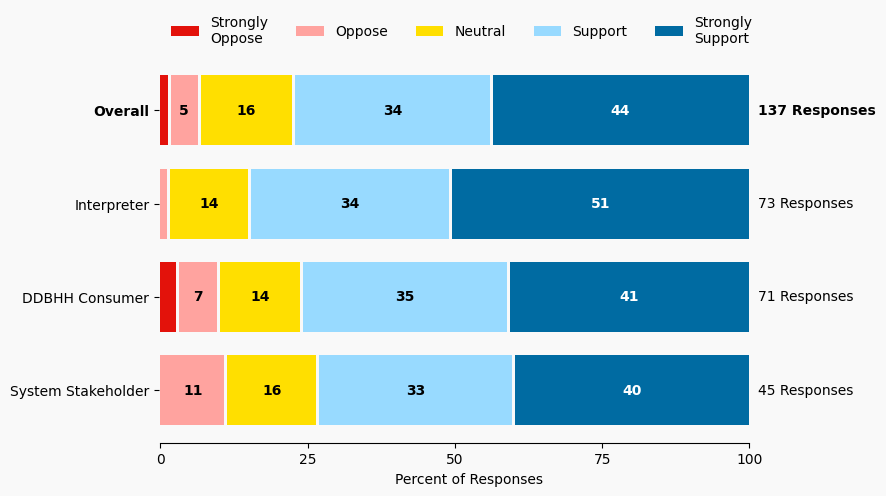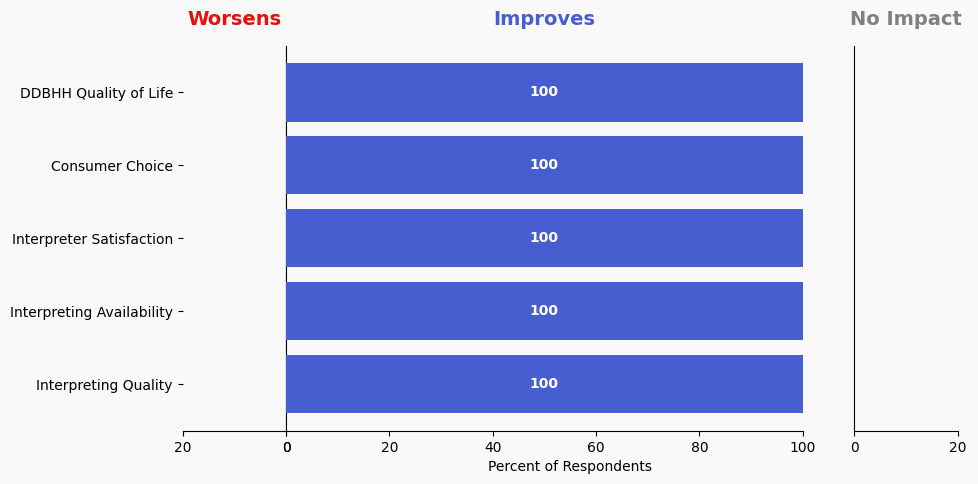13 Require All Major Local News Services to Provide Picture-in-Picture Interpreters
Issue: DDBHH Minnesotans do not all have clear access to news in the local communities where they live.
Proposed Solution: Proposed solution: Commission advocate for requiring local news services to provide picture-in-picture interpreters.
Expected outcome: DDBHH Minnesotans would become more informed citizens. Interpreters, particularly CDIs, would have greater work options. Increased awareness of DDBHH communities and interpreting as a profession. Increased public awareness of ASL and normalizing ASL at public events would also create more inclusive settings.
Who is impacted: Consumers, interpreters
Timeline: 6 months

Summary of Support Image Description
The stacked bar charts show how respondents rated their level of support and the total number of responses. The percentage for the five support levels is shown from left to right: Strongly Oppose (Dark Red), Oppose (Light Red), Neutral (Yellow), Support (Light Blue), and Strongly Support (Dark Blue).
Respondents may identify with multiple subgroups. The overall level of support is:
Overall
Strongly Oppose: 1%
Oppose: 5%
Neutral: 16%
Support: 34%
Strongly Support: 44%
Click to see the detailed image description for each subgroup.
Interpreter
Strongly Oppose: 0%
Oppose: 1%
Neutral: 14%
Support: 34%
Strongly Support: 51%
DDBHH Consumer
Strongly Oppose: 3%
Oppose: 7%
Neutral: 14%
Support: 35%
Strongly Support: 41%
System Stakeholder
Strongly Oppose: 0%
Oppose: 11%
Neutral: 16%
Support: 33%
Strongly Support: 40%
Overview of Respondents Opting for In-Depth Solution Analysis
After indicating their support level, 2% of the 137 respondents opted in to further assess whether the solution would worsen or improve on five metrics. Of the opt-in reviewers (4 respondents), 75% supported the solution, 25% were neutral on the solution, and 0% opposed the solution.
The remaining 133 respondents did not opt in to further assess the solution. Of these people, 77% support the solution, 15% were neutral on the solution, and 6% opposed the solution.
Reviewer Evaluation of Solution Effectiveness

Solution Effectiveness Image Description
The stacked bar charts show how respondents assessed the effectiveness of this solution based on five metrics. For each metric, the percentage of respondents is shown from left to right: Worsens (Red), Improves (Blue), No Impact (Gray).
DDBHH Quality of Life
Makes It Worse 0%
Makes It Better 100%
No Impact 0%
Interpreter Satisfaction
Makes It Worse 0%
Makes It Better 100%
No Impact 0%
Consumer Choice
Makes It Worse 0%
Makes It Better 100%
No Impact 0%
Interpreting Availability
Makes It Worse 0%
Makes It Better 100%
No Impact 0%
Interpreting Quality
Makes It Worse 0%
Makes It Better 100%
No Impact 0%
Reviewer Feedback and Insights
Interpreter
Comments from Interpreters agreed that the increase in interpreter visibility could lead to more interest in the profession.
Deaf, DeafBlind, Hard of Hearing
Comments from DDBHH Consumers expressed support and indicated that the solution implementation needs to prioritize the inclusion of Deaf interpreters, and to avoid challenges experienced by consumers in countries that have already implemented this solution. Specifically, a requirement of PiP combined with a low availability and quality of interpreting leads to incorrect or inadequate communication, and the lack of standardized PiP sizes leads to inconsistent accessibility.
System Stakeholder
Comments from System stakeholders agreed that this solution would increase availability of interpreters by promoting interpreting as a profession.
PREVIOUS SOLUTION
12 Support Business Development by Developing a Public State Payscale for Freelancers
Issue: There is no clear or consistent payscale for freelance interpreters.
NEXT SOLUTION
14 Expand Deaf, DeafBlind and Hard of Hearing State Services Grants
Issue: There are multiple needs for interpreting supports to increase the quality and availability of interpreters, particularly in Greater Minnesota and for DeafBlind consumers.
Leave a Reply